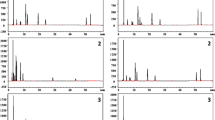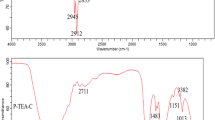Abstract
We used water-contained surfactant-based vortex-assisted microextraction (WSVAME) as a green extraction method followed by high-performance liquid chromatography (HPLC) to determine the content of quercetin as natural antioxidant in different oil samples. During the WSVAME procedure, micellar solution of cationic surfactant cetyltrimethylammonium bromide (CTAB) was injected into oil samples in a conical-bottom glass tube to form cloudy solution. The dispersion process was accelerated by vortex mixing. After extraction and phase separation by centrifugation, the lower sediment phase was directly analyzed by HPLC. Optimization of extraction factors such as the volume and concentration of extraction solvent (aqueous solution of CTAB), percentage of acetic acid added to the oil sample, and vortex time was carried out using the chemometrics approach. Under the optimum condition (30 μL of 0.15 mol L−1 CTAB solution and vortex time of 1 min) the calibration curve was linear in the range of 0.1–100.0 μg mL−1 for hazelnut, olive, and coconut oil and 0.1–120.0 μg mL−1 for almond and grapeseed oil, with correlation coefficient (R 2) greater than 0.996. The limits of detection were 0.01–0.06 μg mL−1.
Graphical abstract



Similar content being viewed by others

References
Iwashina T (2000) The structure and distribution of the flavonoids in plants. J Plant Res 113:287–299
Pietta P-G (2000) Flavonoids as antioxidants. J Nat Prod 63:1035–1042
Shetty A, Rashmi R, Rajan M, Sambaiah K, Salimath P (2004) Antidiabetic influence of quercetin in streptozotocin-induced diabetic rats. Nutr Res 24:373–381
Cheong H, Ryu S-Y, Oak M-H, Cheon S-H, Yoo G-S, Kim K-M (1998) Studies of structure activity relationship of flavonoids for the anti-allergic actions. Arch Pharm Res 21:478–480
Benavente-García O, Castillo J, Marin FR, Ortuño A, Del Río JA (1997) Uses and properties of citrus flavonoids. J Agric Food Chem 45:4505–4515
Benavente-Garcia O, Castillo J (2008) Update on uses and properties of citrus flavonoids: new findings in anticancer, cardiovascular, and anti-inflammatory activity. J Agric Food Chem 56:6185–6205
de Rijke E, Out P, Niessen WM, Ariese F, Gooijer C, Udo AT (2006) Analytical separation and detection methods for flavonoids. J Chromatogr A 1112:31–63
Hu J, Calomme M, Lasure A, De Bruyne T, Pieters L, Vlietinck A, Berghe DV (1995) Structure-activity relationship of flavonoids with superoxide scavenging activity. Biol Trace Elem Res 47:327–331
Murakami A, Ashida H, Terao J (2008) Multitargeted cancer prevention by quercetin. Cancer Lett 269:315–325
Hertog MG, Kromhout D, Aravanis C, Blackburn H, Buzina R, Fidanza F, Giampaoli S, Jansen A, Menotti A, Nedeljkovic S (1995) Flavonoid intake and long-term risk of coronary heart disease and cancer in the seven countries study. Arch Intern Med 155:381–386
Hertog MG, Feskens EJ, Kromhout D, Hollman P, Katan M (1993) Dietary antioxidant flavonoids and risk of coronary heart disease: the Zutphen Elderly Study. Lancet 342:1007–1011
De La Lastra CA, Martin MJ, Motilva V (1994) Antiulcer and gastroprotective effects of quercetin: a gross and histologic study. Pharmacology 48:56–62
Chaudhry PS, Cabrera J, Juliani HR, Varma SD (1983) Inhibition of human lens aldose reductase by flavonoids, sulindac and indomethacin. Biochem Pharmacol 32:1995–1998
Park H-H, Lee S, Son H-Y, Park S-B, Kim M-S, Choi E-J, Singh TS, Ha J-H, Lee M-G, Kim J-E (2008) Flavonoids inhibit histamine release and expression of proinflammatory cytokines in mast cells. Arch Pharmacal Res 31:1303–1311
Galati G, Sabzevari O, Wilson JX, O’Brien PJ (2002) Prooxidant activity and cellular effects of the phenoxyl radicals of dietary flavonoids and other polyphenolics. Toxicology 177:91–104
Sung M-T, Chen Y-C, Chi C-W (2014) Chapter 22—Quercetin’s potential to prevent and inhibit oxidative stress-induced liver cancer. In: Preedy V (ed) Cancer. Academic, San Diego, pp 231–239
Steinmetz KA, Potter JD (1996) Vegetables, fruit, and cancer prevention: a review. J Am Diet Assoc 96:1027–1039
Miean KH, Mohamed S (2001) Flavonoid (myricetin, quercetin, kaempferol, luteolin, and apigenin) content of edible tropical plants. J Agric Food Chem 49:3106–3112
Roedig-Penman A, Gordon MH (1998) Antioxidant properties of myricetin and quercetin in oil and emulsions. J Am Oil Chem Soc 75:169–180
Watson D, Oliveira E (1999) Solid-phase extraction and gas chromatography–mass spectrometry determination of kaempferol and quercetin in human urine after consumption of Ginkgo biloba tablets. J Chromatogr B Biomed Sci Appl 723:203–210
Canini A, Alesiani D, D’Arcangelo G, Tagliatesta P (2007) Gas chromatography–mass spectrometry analysis of phenolic compounds from Carica papaya L. leaf. J Food Compost Anal 20:584–590
Ranjbari E, Biparva P, Hadjmohammadi MR (2012) Utilization of inverted dispersive liquid–liquid microextraction followed by HPLC-UV as a sensitive and efficient method for the extraction and determination of quercetin in honey and biological samples. Talanta 89:117–123
Zu Y, Li C, Fu Y, Zhao C (2006) Simultaneous determination of catechin, rutin, quercetin kaempferol and isorhamnetin in the extract of sea buckthorn (Hippophae rhamnoides L.) leaves by RP-HPLC with DAD. J Pharm Biomed Anal 41(3):714–719
Hadjmohammadi MR, Nazari S, Kamel K (2009) Determination of flavonoid markers in honey with SPE and LC using experimental design. Chromatographia 69:1291–1297
Asadollahi T, Dadfarnia S, Haji Shabani A, Amirkavei M (2015) Separation/preconcentration and determination of quercetin in food samples by dispersive liquid–liquid microextraction based on solidification of floating organic drop-flow injection spectrophotometry. J Food Sci Technol 52:1103–1109
Baranowska I, Raróg D (2001) Application of derivative spectrophotometry to determination of flavonoid mixtures. Talanta 55:209–212
Ferey L, Delaunay N, Rutledge DN, Cordella CBY, This H, Huertas A, Raoul Y, Gareil P (2014) Optimizing separation conditions of 19 polycyclic aromatic hydrocarbons by cyclodextrin-modified capillary electrophoresis and applications to edible oils. Talanta 119:572–581
Ferey L, Delaunay N, Rutledge DN, Huertas A, Raoul Y, Gareil P, Vial J (2013) Use of response surface methodology to optimize the simultaneous separation of eight polycyclic aromatic hydrocarbons by capillary zone electrophoresis with laser-induced fluorescence detection. J Chromatogr A 1302:181–190
Xiao P, Zhao F, Zeng B (2007) Voltammetric determination of quercetin at a multi-walled carbon nanotubes paste electrode. Microchem J 85:244–249
Jin G-P, He J-B, Rui Z-B, Meng F-S (2006) Electrochemical behavior and adsorptive stripping voltammetric determination of quercetin at multi-wall carbon nanotubes-modified paraffin-impregnated graphite disk electrode. Electrochim Acta 51:4341–4346
Budejovice CE (2001) Application of micellar electrokinetic capillary chromatography for quantitative analysis of quercetin in plant materials. Electrophoresis 22:1573–1578
Sun Y, Fang N, Chen DDY, Donkor KK (2008) Determination of potentially anti-carcinogenic flavonoids in wines by micellar electrokinetic chromatography. Food Chem 106:415–420
André C, Castanheira I, Cruz JM, Paseiro P, Sanches-Silva A (2010) Analytical strategies to evaluate antioxidants in food: a review. Trends Food Sci Technol 21:229–246
Melwanki MB, Fuh M-R (2008) Partitioned dispersive liquid–liquid microextraction: an approach for polar organic compounds extraction from aqueous samples. J Chromatogr A 1207:24–28
Regueiro J, Llompart M, Garcia-Jares C, Garcia-Monteagudo JC, Cela R (2008) Ultrasound-assisted emulsification–microextraction of emergent contaminants and pesticides in environmental waters. J Chromatogr A 1190:27–38
Yazdi AS (2011) Surfactant-based extraction methods. Trends Anal Chem 30:918–929
Amlashi NE, Hadjmohammadi MR, Nazari SSSJ (2014) Water-contained surfactant-based vortex-assisted microextraction method combined with liquid chromatography for determination of synthetic antioxidants from edible oil. J Chromatogr A 1361:9–15
Amlashi NE, Hadjmohammadi MR (2016) Utilization of water-contained surfactant-based ultrasound-assisted microextraction followed by liquid chromatography for determination of polycyclic aromatic hydrocarbons and benzene in commercial oil sample. J Iran Chem Soc 1–8
Lu L, Zhu L (2012) Effect of a cationic surfactant on the volatilization of PAHs from soil. Environ Sci Pollut Res 19:1515–1523
Ma JC, Dougherty DA (1997) The cation–π interaction. Chem Rev 97:1303–1324
Rezaei F, Yamini Y, Moradi M, Daraei B (2013) Supramolecular solvent-based hollow fiber liquid phase microextraction of benzodiazepines. Anal Chim Acta 804:135–142
Michalkiewicz MBA, Pyrzynska K (2008) Solid-phase extraction procedure for determination of phenolic acids and some flavonols in honey. J Chromatogr A 1187:18–24
Pirisi FM, Cabras P, Cao CF, Migliorini M, Muggelli M (2000) Phenolic compounds in virgin olive oil. 2. Reappraisal of the extraction, HPLC separation, and quantification procedures. J Agric Food Chem 48:1191–1196
Author information
Authors and Affiliations
Corresponding author
Ethics declarations
Conflict of interest
All authors declare that they have no conflict of interest.
This article does not contain any studies with human participants or animals performed by any of the authors.
Electronic supplementary material
Below is the link to the electronic supplementary material.
Rights and permissions
About this article
Cite this article
Ekbatani Amlashi, N., Hayati, Z. & Hadjmohammadi, M. Micellar Solution as Green Extractive Solvent for Determination of Content of Quercetin as Natural Antioxidant in Oil Samples. Chromatographia 80, 873–880 (2017). https://doi.org/10.1007/s10337-017-3314-2
Received:
Revised:
Accepted:
Published:
Issue Date:
DOI: https://doi.org/10.1007/s10337-017-3314-2



